I'm trying to follow along the Stanford CS193p iOS programing lectures. One of the demo programs, called "Happiness" creates two UIViewControllers, a "PsychViewController" and a "HappinessViewController." It segues from the PsychViewController to the HappinessViewController using a target action method.
The following code keeps throwing this exception: "-[UIViewController setHappiness:]: unrecognized selector sent to instance"
Here's the offending code:
-(void)prepareForSegue:(UIStoryboardSegue *)segue sender:(id)sender
{
if ([segue.identifier isEqualToString:@"ShowDiagnosis"]) {
[segue.destinationViewController setHappiness:7];
}
}
I have searched this site and others, and the usually when this error comes up, it is because the generic UIViewController has not been correctly set to the specific view controller object used in the program, in this case the "HappinessViewController." But I have set the generic UIViewController to be a HappinessViewController using the identity inspector in IB, and I am still getting the exception. I am tearing my hair out, if anyone could help it would be much appreciated.

